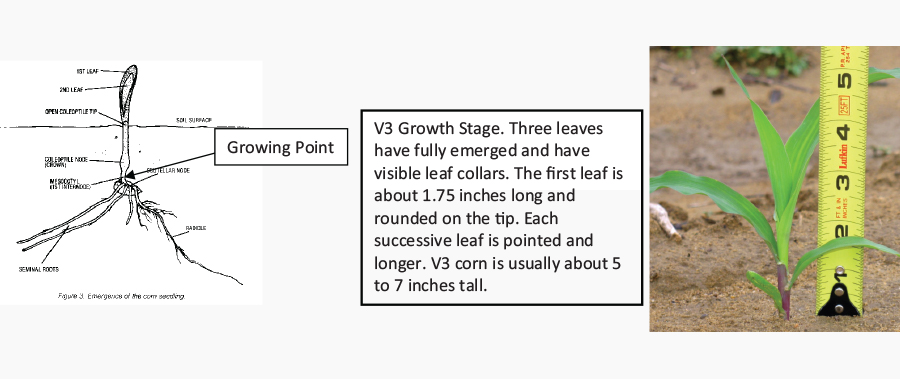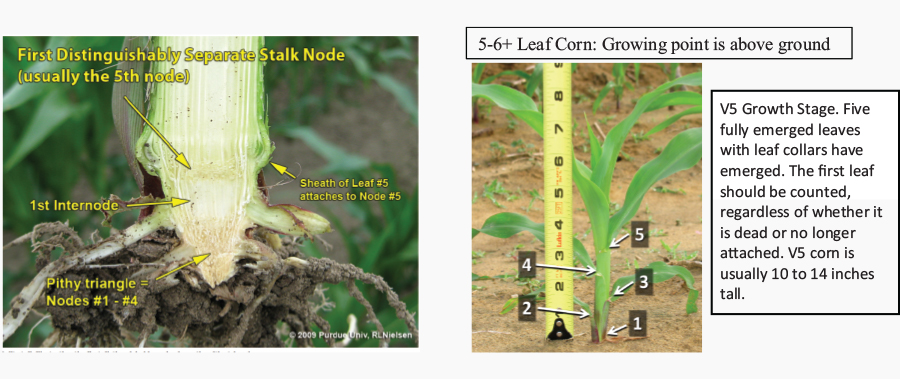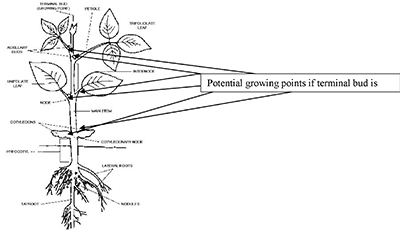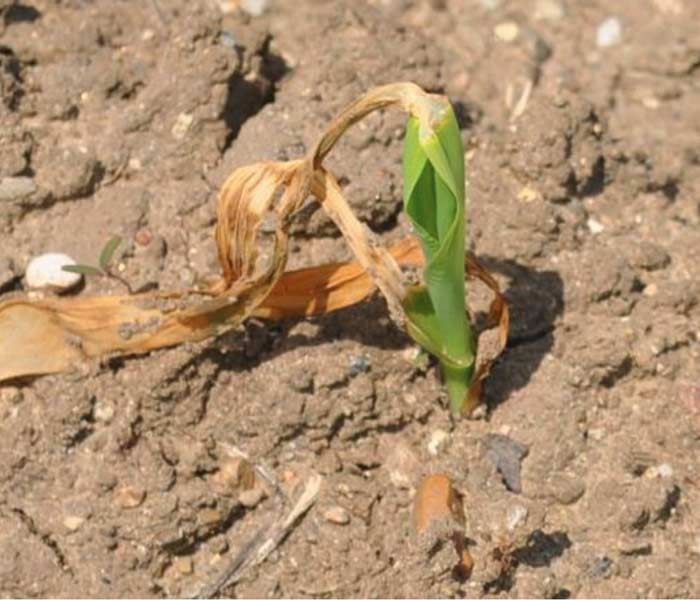Are Your Crops Frost Damaged?
Frost has speckled a few areas of the across the northern Midwest this weekend. Fortunately, most of the corn has the growing point below ground and soybeans are either not planted or they have not emerged. However, some of the Midwest, these crops are at more susceptible stages for injury. Frost issues create a number of grower questions as to their effect on emerged corn and soybeans. The following may help answer some of these questions.
Whenever frost occurs and crops are damaged, growers request help in assessing the extent of the crop damage. Often they want someone to come the same day or day following a frost. To more accurately diagnose the extent of damage and chances of recovery, examination of affected plants should be delayed for a few days (usually a minimum of 3-4 days) following the frost.
Generally speaking, final stands and yield of corn are not affected by frost that occurs during the 4-leaf stage of growth and earlier. Above ground plant tissue can be frozen, turn gray, and wilt; however, the growing point which is below the soil surface at this stage of growth is generally not affected. If weather conditions should warm up, normal growth would be expected to occur. If weather conditions following a frost remain cool and wet, instead of drying up, above ground leaf tissue may begin to decay. This decay or mold can move down in the plant and eventually affect the growing point. The duration of below freezing temperatures is also important. If freezing temperatures persist for more than just a couple of hours, the growing point (even below ground) may be affected.
 At about the 5-leaf stage of growth, the growing point is at the soil surface and will be above ground with further growth. The growing point is in the center of the developing above ground stalk and is protected somewhat from freezing conditions; however, there is a greater risk of significant damage compared to earlier growth stages. Look for any discolorations to indicate damage or stress.
At about the 5-leaf stage of growth, the growing point is at the soil surface and will be above ground with further growth. The growing point is in the center of the developing above ground stalk and is protected somewhat from freezing conditions; however, there is a greater risk of significant damage compared to earlier growth stages. Look for any discolorations to indicate damage or stress.
 To assess the damage to young corn seedlings, dig up a number of plants and carefully dissect them to expose the growing point. On 4-leaf corn, the growing point will generally be 0.5-1” below the soil surface. If the growing point is firm and not a discolored gray, tan or brown, normal growth will occur as the weather warms up. A water-soaked, discolored growing point indicates that the growing point is injured and probably dead. Too often growers jump the gun and replant when all that was actually damaged was some leaf tissue resulting in cosmetic damage, but no real yield or stand reductions.
To assess the damage to young corn seedlings, dig up a number of plants and carefully dissect them to expose the growing point. On 4-leaf corn, the growing point will generally be 0.5-1” below the soil surface. If the growing point is firm and not a discolored gray, tan or brown, normal growth will occur as the weather warms up. A water-soaked, discolored growing point indicates that the growing point is injured and probably dead. Too often growers jump the gun and replant when all that was actually damaged was some leaf tissue resulting in cosmetic damage, but no real yield or stand reductions.
 Unlike corn, the growing point on soybean seedlings is above ground from emergence on. Soybeans can actually withstand temperatures lower than corn without significant damage; however, the growing point is exposed making them more susceptible to freezing temperatures. All of the leaf tissue on soybeans may be injured and turn black or brown and the soybean plant can still recover. There are axillary buds located at the attachment area of the cotyledons, unifoliate and trifoliate leaves that can develop if the leaves and terminal growing point are damaged. As long as these axillary buds are not damage by the frost, the plant can recover.
Unlike corn, the growing point on soybean seedlings is above ground from emergence on. Soybeans can actually withstand temperatures lower than corn without significant damage; however, the growing point is exposed making them more susceptible to freezing temperatures. All of the leaf tissue on soybeans may be injured and turn black or brown and the soybean plant can still recover. There are axillary buds located at the attachment area of the cotyledons, unifoliate and trifoliate leaves that can develop if the leaves and terminal growing point are damaged. As long as these axillary buds are not damage by the frost, the plant can recover.
To assess the extent of damage to soybeans caused by freezing conditions, you need to examine the plants to see if just the leaf tissue is affected or whether the axillary buds have also been damaged. Axillary buds located at each node need to be examined. If the buds are dark green or black, the plant is probably dead. Again, like in corn, don’t be too hasty in making a replant decision. Give it several days to determine what percent of the actual stand is affected. Soybeans can compensate very well for stand reductions early in the season.
Contact your local Premier agronomist if you have any questions on assessing your crops for frost damage.
Grant Kemink
District Sales Representative
Winfield United


 At about the 5-leaf stage of growth, the growing point is at the soil surface and will be above ground with further growth. The growing point is in the center of the developing above ground stalk and is protected somewhat from freezing conditions; however, there is a greater risk of significant damage compared to earlier growth stages. Look for any discolorations to indicate damage or stress.
At about the 5-leaf stage of growth, the growing point is at the soil surface and will be above ground with further growth. The growing point is in the center of the developing above ground stalk and is protected somewhat from freezing conditions; however, there is a greater risk of significant damage compared to earlier growth stages. Look for any discolorations to indicate damage or stress. To assess the damage to young corn seedlings, dig up a number of plants and carefully dissect them to expose the growing point. On 4-leaf corn, the growing point will generally be 0.5-1” below the soil surface. If the growing point is firm and not a discolored gray, tan or brown, normal growth will occur as the weather warms up. A water-soaked, discolored growing point indicates that the growing point is injured and probably dead. Too often growers jump the gun and replant when all that was actually damaged was some leaf tissue resulting in cosmetic damage, but no real yield or stand reductions.
To assess the damage to young corn seedlings, dig up a number of plants and carefully dissect them to expose the growing point. On 4-leaf corn, the growing point will generally be 0.5-1” below the soil surface. If the growing point is firm and not a discolored gray, tan or brown, normal growth will occur as the weather warms up. A water-soaked, discolored growing point indicates that the growing point is injured and probably dead. Too often growers jump the gun and replant when all that was actually damaged was some leaf tissue resulting in cosmetic damage, but no real yield or stand reductions.  Unlike corn, the growing point on soybean seedlings is above ground from emergence on. Soybeans can actually withstand temperatures lower than corn without significant damage; however, the growing point is exposed making them more susceptible to freezing temperatures. All of the leaf tissue on soybeans may be injured and turn black or brown and the soybean plant can still recover. There are axillary buds located at the attachment area of the cotyledons, unifoliate and trifoliate leaves that can develop if the leaves and terminal growing point are damaged. As long as these axillary buds are not damage by the frost, the plant can recover.
Unlike corn, the growing point on soybean seedlings is above ground from emergence on. Soybeans can actually withstand temperatures lower than corn without significant damage; however, the growing point is exposed making them more susceptible to freezing temperatures. All of the leaf tissue on soybeans may be injured and turn black or brown and the soybean plant can still recover. There are axillary buds located at the attachment area of the cotyledons, unifoliate and trifoliate leaves that can develop if the leaves and terminal growing point are damaged. As long as these axillary buds are not damage by the frost, the plant can recover. 

